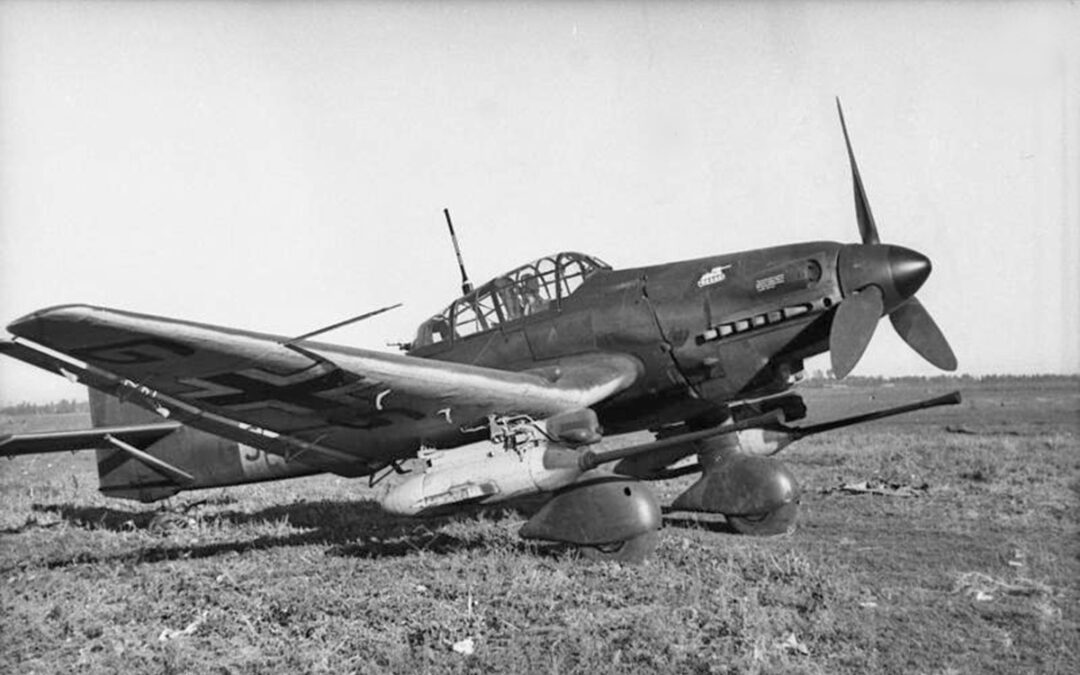In 1943 the Ju 87 Stuka was committed to a new and very specialised role, as the Ju 87 G anti-tank aircraft with a pair of underwing 37 mm cannons. Only a handful of units were ever equipped with the new weapon, but one of those was the 10. Staffel of Schlachtgeschwader 1, shortened to 10.(Pz.)/SG 1, which was created in January 1944 with the re-designation of 10.(Pz.)/SG 77.
The unit was based on the central sector of the Eastern Front throughout the first half of 1944, supporting Heeresgruppe Mitte, the German army formation occupying that sector, with Luftflotte 6 as its higher headquarters. Losses were not heavy, with only five reported between January and April 1944, and one pilot wrote in a letter home in February: “Everything is not so bad and the losses are tolerable. Only Ivan’s Flak is really strong and shoots very accurately.” The Staffelkapitän in 1944 was Oberleutnant Günther Jacoby, who would be promoted to the rank of Hauptmann in June. In March 1944 the unit took on ten conventional dive-bomber Ju 87 D-5s from another unit, and until August would actually have more of that type on strength than the dedicated anti-tank variants of the Ju 87, the G-1 and G-2.
On 22 June 1944 the Soviets launched Bagration, their massive offensive aimed at destroying Heeresgruppe Mitte. When the Red Army began its attack, 10.(Pz.)/SG 1 was attached to the Ju 87-equipped I./SG 1, serving under 1. Flieger–Division at Milanow airfield, to the east of Warsaw, with the Staffel having eleven serviceable Ju 87s out of twenty. Milanow was 500 kilometres south-west of the focal point for Bagration, and before 22 June 1944 was over, both Stuka units had been hastily transferred north to the sector of 4. Flieger–Division, where the main part of the Red Army offensive was occurring against 3. Panzerarmee in eastern Belarus.
The 10. Staffel was initially rushed to Bojari, to the north-east of the primary Soviet objective of Minsk, and right in the path of the offensive. It then rejoined I./SG 1 at Matschulitsche, south of Minsk, but by 2 July it had fallen back yet again to a new airfield, at Lida, where a battle group had been assembled with the fighters of the Stabsstaffel JG 51, the Stab of JG 51, and III./JG 52, the Ju 87 Ds of I./SG 1, and 10.(Pz.)/SG 1 with its Ju 87 Ds and Gs. Serviceability had become a real issue by this stage, with only four of the unit’s twenty Ju 87s ready for operations.

Despite the chaotic situation and the constant moves from airfield to airfield, the Staffel suffered relatively few combat losses in the early stages of the Red Army offensive. This did not mean that they suffered no losses as the offensive wore on. On 11 July a crew crashed and both men were killed after being hit by anti-aircraft fire to the south-west of Wilna (modern Vilnius, Lithuania).
On the morning of 24 July, the Staffel took off from Dubovo airfield to participate in a regular ground-attack mission with I./SG 1. Their target was an important bridge over the Memel (Niemen) River at Darsuniskis, where the 3. Belorussian Front was trying to advance to the south of the key city of Kaunas. An earlier mission by thirteen Stukas had been unsuccessful, but this time, the Ju 87 crews were able to destroy the bridge with their bombs. However, in the process, one of the Ju 87 D-5s from 10.(Pz.)/SG 1 was shot down by a Soviet fighter from the 1.VA (1st Air Army). The German pilot later recalled some terrifying moments: “… the La-5 got within 200 to 300 feet behind us and opened fire. His first burst shot up the fuel line and hit the fuel tank. I had fuel everywhere in the cockpit and it exploded and set me on fire.” However, despite the exceedingly dangerous situation, the pilot survived the crash-landing, although the unfortunate gunner was killed. The Soviet fighter pilots of 2.IAK (2nd Fighter Corps) optimistically claimed six Stukas destroyed in aerial combat near Darsuniskis on this morning, but only two were actually lost.

By the end of July, the Staffel was down to just ten aircraft on strength, of which only one was a Ju 87 G, so despite the unit’s designation, its anti-tank capabilities were limited. With the land fighting dying down after the very successful Soviet summer offensive had run out of steam, early August 1944 saw 10.(Pz.)/SG 1 properly re-equipped, taking on strength eleven Ju 87 G-2s, seven of which were brand new. This gave it genuine anti-tank capability for the first time in months, meaning it could cease flying regular Stuka operations.
The unit would continue to operate on the Eastern Front until the end of 1944, providing its final strength return on 31 December 1944, which indicated that it was converting to the Fw 190. Then, during the first week of January 1945, the Staffel was re-designated to become part of I.(Pz.)/SG 9 and fight on in the last desperate actions of the war on the Eastern Front.
Primary Sources
BA-MA RL 2-II/3812
BA-MA RL 2-II/3815
BA-MA RL 2-III/730
BA-MA RL 2-III/732
BA-MA RL 2-III/734
BA-MA RL 21/249
NARA RG 242 T-311 R-228
NARA RG 242 T-312 R-1304
USAFHRA Microfilm Roll No. K1027M
1. VA War Diary
Flugzeugbestand und Bewegungsmeldungen
Lenz, Hans Letter 27 February 1944
Secondary Sources
Bergstrom, Christer Bagration to Berlin – the Final Air Battles in the East: 1944-1945, Classic Publications, Hersham, 2008.
deZeng, Larry & Stankey, Douglas G. ‘Luftwaffe Officer Career Summaries’, 2022.
McCaul, Ed ‘Tank-Busting Stuka Pilot’, in Military History, August 2001.
Electronic Sources
Holm, Michael ‘The Luftwaffe, 1933-45’, http://www.ww2.dk
Acknowledgements
Michael Balss, Andreas Brekken, John Calvin, Andrey Kuznetsov, Matti Salonen, Dan Zamansky





